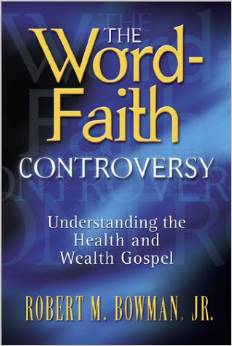Robert Bowman: The Word-Faith Controversy
 Robert M. Bowman, Jr., The Word-Faith Controversy: Understanding the Health and Wealth Gospel (Grand Rapids: Baker, 2001), 254 pages, ISBN 9780801063442.
Robert M. Bowman, Jr., The Word-Faith Controversy: Understanding the Health and Wealth Gospel (Grand Rapids: Baker, 2001), 254 pages, ISBN 9780801063442.
When I came across Bowman’s book The Word-Faith Controversy, I was very interested in his approach and conclusions because I had earlier done my Th.D. dissertation on nineteenth and twentieth century “faith theologies.” Bowman’s book is a significant contribution to the study of the Word of Faith movement. While not uncritical of the movement, he takes exception to many of the conclusions of Hank Hanegraaff (Christianity in Crisis) and D.R. McConnell (A Different Gospel). Contrary to Hanegraaff, he does not portray the movement as monolithic, but recognizes diversity and disagreement within the movement.
Bowman prefers to call E.W. Kenyon the “grandfather” of the Word-Faith movement, citing what he considers three other “fathers”: William Branham and the Latter Rain movement, Oral Roberts (whom he does not classify as Word-Faith), and especially Kenneth Hagin. He recognizes that Kenyon would not accept all that is taught in the Word-Faith movement (e.g., that God has a body or that believers are little gods), nor would Word-Faith leaders accept all that Kenyon taught (e.g., that tongues is not the initial evidence of the baptism in the Spirit). He concludes, “Kenyon is the source of most, but not all, of the distinctive and controversial teachings of the Word-Faith movement” (p. 38). Further, the Word-Faith teachers have sometimes gone beyond anything that Kenyon himself taught.
Taking a more scientific approach than McConnell and Hanegraaff, Bowman lists and compares 23 standard New Thought concepts with Christian Science and Kenyon. From this statistical analysis, he concludes that while there is much in common between Christian Science and New Thought, there is “little resemblance” between Kenyon and New Thought. Further, he concludes that Kenyon is “far closer to orthodoxy than is Christian Science” (p. 46). Kenyon may share some similarity with metaphysical thought, but his views are “fundamentally different” (p. 48). He demonstrates that McConnell’s methodology is faulty, and thus his conclusions regarding Kenyon’s connections with metaphysical New Thought are deeply flawed. While there may have been some metaphysical influence, Kenyon’s views are more unlike such concepts than like.
Bowman goes on to show that Kenyon’s teaching was rooted more in the pre-Pentecostal Higher Life, Keswick, healing and proto-Pentecostal movements. He cites examples of such teaching including Andrew Murray, Hannah Whitall Smith, Charles Cullis, A.J. Gordon, and others, especially concentrating on the teachings of A.B. Simpson and John G. Lake. He is less critical of the Keswick/Higher Life stream than Dale Simmons (E.W. Kenyon and the Postbelllum Pursuit of Peace, Power, and Prosperity), seeing less similarity between the Keswick/Higher Life tradition and metaphysical teaching.
Category: Ministry, Spring 2004


